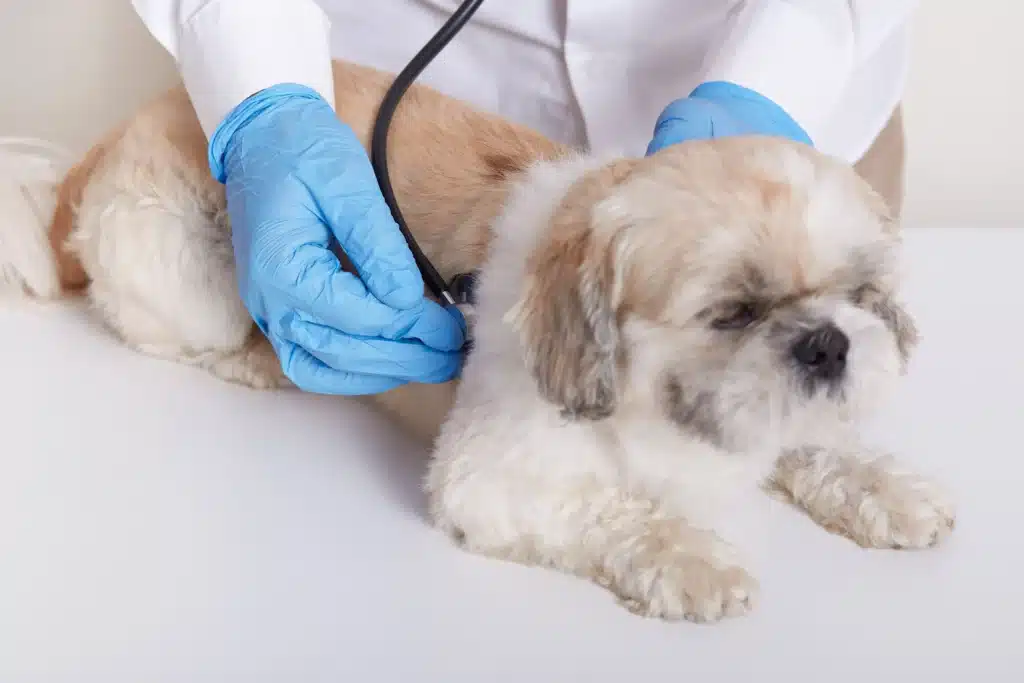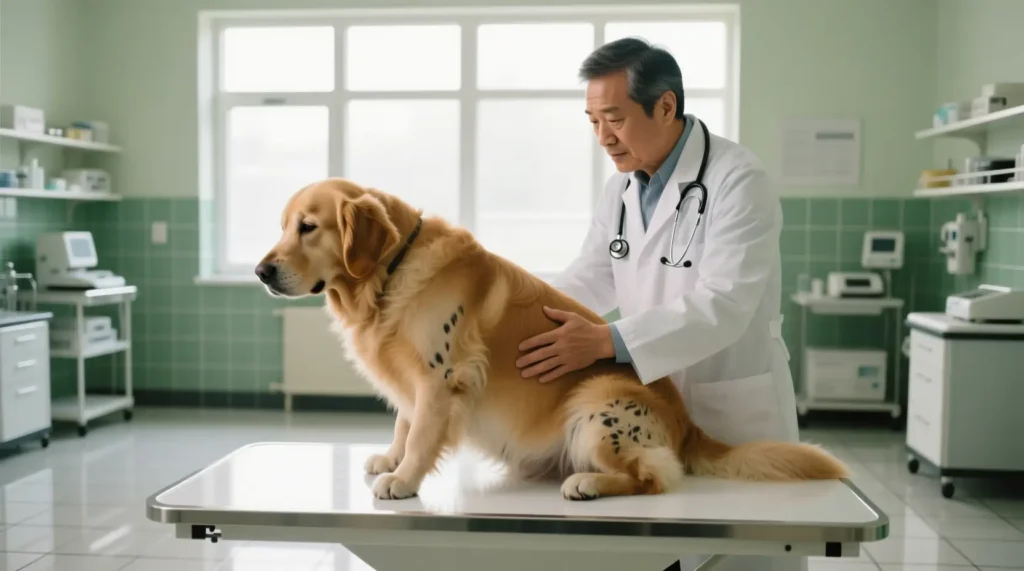Dog obesity is becoming one of the largest health issues in veterinary medicine today. Just like in humans, excess body fat in dogs is not just for looks, it is a disease with numerous downstream issues with health, lifetime, and quality of life. This research is focusing on how we define obesity, why some dogs are more predisposed than others, and which interventions are most effective. Below is an in-depth, comprehensive, and contemporary review.
What Is Obesity (and Overweight) in Dogs?
Overweight typically indicates a weight that exceeds ideal weight by 10-20% and obesity is thought to be a weight that is 20% or more than ideal body weight (VCA Animal Hospital, 2022).
Prevalence of Overweight and Obesity in Dogs by Life Stage
| Life Stage | Overweight (%) | Obese (%) | Source |
| Young Adult Dogs | 24.4% | 1.9% | (Montoya et al., 20250 |
| Adult Dogs | 44.5% | 8.4% | (Montoya et al., 20250 |
| Mature Dogs | 50.1% | 12.6% | (Montoya et al., 20250 |
| Senior Dogs | 46.4% | 11.3% | (Montoya et al., 20250 |
Obesity is a chronic disease, which may arrive from many causes, resulting in excessive storage of adipose (fat) tissue, with consequences for metabolic, hormonal, musculoskeletal, and organ health.
Fat is biologically active, secreting inflammatory mediators (i.e., adipokines), leading to low-grade systemic inflammation, increased oxidative stress, and more, contributing to multiple chronic conditions.
Obesity Signs & Clinical Indicators
Recognizing overweight or obese dogs early can help prevent serious health problems. Signs to look for include:
Physical signs
1Ribs may not be easily touched under a layer of fat (Grota, 2022).
Reduced waist circumference, or tuck behind the ribs when viewing from a side profile; when viewed from the top, the hourglass shape disappears with no definitive waist narrowing behind the ribs.
Fat excessive tissue can be noted in areas around the trunk, abdomen, at the base of the tail, and tissue folds around the neck.
Behavioral / performance signs
Dogs are not as energetic and may tire more easily while walking or playing.
Heat intolerance: during warmer weather, dogs may pant and just not do as well.
The dog is unable to move, jump up, or play in the same manner as they did before because of excess weight; the risk for arthritis increases.
Health diagnostics
Biomarkers of excess fat and changes in liver enzymes (i.e., with ALP, GGT) indicating stress on the liver.
Association for Pet Obesity Prevention
It is typical to employ Body Condition Score (BCS) charts that are on a 5-point or 9-point scale (with 3/5 or 4-5/9 being the ideal area of the scale) (Grota, 2022).
More sophisticated tools involve bioelectrical impedance, DEXA (dual energy X-ray absorptiometry), ultrasound fat thickness, morphometric indices (abdominal girth), etc.
Causes and Risk Factors
Obesity obviously does not occur in a vacuum. The research indicates that it is a complex interaction of many things:
Energy imbalance
Cornell University College of Veterinary, (2024) explored that,overfeeding (food + treats + table scraps) vs. energy usage. Very often, treats and extras are far from proportional.
Low exercise, Sedentary lifestyle, especially for older dogs or for smaller living situations.
Breed / Genetic predisposition
Some breeds are more food motivated (for example, Labrador Retrievers or Golden Retrievers).
Genetic variants : In the UK and Brazil have identified genes that correlate with body fat level (an example would be a DENND1B variant, among other loci) in certain breeds (Morris Animal Foundation, 2025).
Age, neutered status, medical/hormonal conditions.
As dogs get older, their metabolic rate tends to drop – combined with reduced activity, this will put them at higher risk for becoming overweight.
Neutered dogs have an increased risk for weight gain (changes in their metabolism, appetites, etc.).
Medical causes (hypothyroidism, Cushing’s disease, etc.)
Environmental, owner behavior, socioeconomic status
Living urban vs. rural: space for exercise, parks available, etc. may impact.
Number of dogs in household: if there are multiple dogs, feeding practices may be not as strict.
Risks and Health Effects
The risks or effects that overweight dogs encounter or aggravate:
Joint disease/osteoarthritis; more wear and tear on joints.
Decreased lifespan
Obese dogs are expected to reduce life by 1-2 years typically.
Cardiovascular risk, having trouble breathing, heat intolerant.
Increased risk of certain types of metabolic issues (insulin resistance, changes in lipids). However, despite being obese a dog is much less likely than a cat to have overt diabetes.
More risk for anesthetic (fat can affect anesthetic dose and recovery)
Liver stress
In being obese there are often elevations in cholestatic liver enzymes (ALP, GGT) and potentially hepatic steatosis evident on imaging, with promising newer diagnostic tools able to aid with detection of this earlier on.
Identifying Obesity: Tools & Best Practices
In order to manage obesity effectively, you must first assess the condition:
Body Condition Score (BCS) is easy, free, and common. Visual + palpation. 5-point and 9-point.
Relative Body Weight: current weight compared to ideal weight.
Morphometric measurements: girth measures, chest vs abdominal circumference.
Imaging / advanced tools:
Ultrasound-based liver fat quantification (attenuation imaging).
American Association for Pet Obesity Prevention
DEXA scans (the gold-standard for fat vs lean mass), typically used in research or in specialty clinics.
Regular veterinary visits:
You’ll be seeing trends in weight (up/down), not just a single measurement.
Strategies for Treatment and Management
Treating and managing obesity is a long-term, multimodal undertaking, not a quick fix.
1. Dietary Modification
Transition to a veterinary-recommended weight-loss food or weight-mangement food with low caloric density and high fiber and moisture for satiety.
Measure portions precisely, avoid ad lib feeding, or free feeding if possible.
Decrease treats and table scraps and include treat calories if any in daily total caloric intake.
2. Increase Physical Activity
- Increased activity should be appropriate for dog age, condition, and breed. Older and overweight dogs can all benefit from more frequent and shorter walks.
- physical activity through play, toys, and stuffed toys to promote activity.
3. Behavior Modification and educating owners
Must demonstrate ideas of the ideal body condition and overweight versus obesity, and work towards realistic attempts.
4. Medical / Pharmacological therapy
At this time, the majority of weight loss in dogs relies upon dietary and exercise modification, although interest appears increasingly in GLP-1 receptor agonists, and drugs that modify either appetite and metabolism with animals (Mitchell, 2024). There are some trials with these medications for canine pets.
For dogs with concurrent medical issues (hypothyroidism, Cushing’s disease) management of these issues are recommended to treat obesity and weight loss.
4. Monitoring and follow-up
Practical Guidelines & Best Practices
| Step | What to Do | Details / Notes |
| 1. Establish Baseline | Estimate ideal weight for breed, size, age. Record Body Condition Score (BCS) and actual weight. If available, use thoracic/abdominal girth or body fat % tools. | Provides a reference point for progress tracking. |
| 2. Evaluate Lifestyle & Feeding Practices | Calculate current calorie intake (food, treats, scraps). Assess feeding schedule (free feeding vs. timed meals). Note food type (energy density, protein/fiber content). Assess physical activity (walks, play, enrichment). | Helps identify contributing factors to obesity. |
| 3. Set Realistic Goals | Aim for 1–2% body weight loss per week. Use small, sustainable changes (diet adjustment, treat reduction, extra activity). | Avoids rapid weight loss which can be unsafe. |
| 4. Implement Changes with Monitoring | Use a veterinary-recommended weight-loss diet if needed. Gradually increase exercise (account for age, joints, health). Reduce treats; use low-calorie treats or non-food rewards (play, attention). | Supports safe and steady weight management. |
| 5. Regular Check-ups | Veterinary monitoring: weight, BCS, possible lab work (lipids, liver enzymes). Adjust diet/exercise if weight loss plateaus. | Ensures accountability and medical safety. |
| 6. Address Underlying Medical Issues | Screen for thyroid disease, Cushing’s, or other endocrine disorders if suspected. If the dog is neutered, adjust caloric intake/exercise plan. | Rule out or manage hidden health conditions. |
Things to Consider
Rapid weight loss can be dangerous; risk of nutritional deficiency and loss of muscle mass.
Over-restriction: starving the dog or using improper home-made diets without a veterinarian’s recommendations.
Assuming one size fits all: breed, age, environment, and medical conditions all affect the strategies we use.
Owner denial / underestimation of weight: many owners think their overweight dog looks “just fine.” Surveys show there are large gaps in the actual overweight rates compared with the owner’s perception.
Conclusion
Obesity in dogs is not simply “extra weight”; it is a very complex chronic disease with numerous causes and long-term health ramifications. The PetMD article lays a good foundation. The most recent research builds on the foundation of the article: we have better tools for diagnostics (imaging, etc.), better understanding of genetic/environmental drivers, potential new pharmacologic supports, and much more sophisticated monitoring of health of related organs (liver and so forth).
For both owners and veterinarians, the best course of action is to recognize the problem earlier, develop and implement an individualized plan tailored to the owner and dog’s goals, target realistic goals, and continuously follow-up with success. Properly addressing obesity issues in a dog(s) can help the vast majority of dogs lose the extra weight, improve their quality of life, reduce serious disease risk, and, in many cases, allow for dogs to live longer and happier lives.
References
VCA Animal Hospital. (2022). Obesity in Dogs | VCA Animal Hospitals. available at. https://vcahospitals.com/know-your-pet/obesity-in-dogs?. Accessed on [21-09-2025]
Grota, J. (2022). Obesity in Dogs. available at: https://www.petmd.com/dog/conditions/digestive/obesity-dogs
Cornell University College of Veterinary. (2024). The Biggest Health Problem in Canine Medicine: Obesity. Cornell University College of Veterinary Medicine. Available at: https://www.vet.cornell.edu/departments-centers-and-institutes/riney-canine-health-center/canine-health-information/biggest-health-problem-canine-medicine-obesity? Accessed on [21-09-2025]
Morris Animal Foundation. (2025). Why Pet Obesity Is Rising: Causes, Risks, and How to Help Your Dog, Cat, or Horse Lose Weight. https://www.morrisanimalfoundation.org/article/weight-loss-in-cats-and-dogs?
Mitchell, A. (2024). Hefty pets may benefit from Ozempic-style drugs, experts say. New York Post. https://nypost.com/2024/07/01/lifestyle/hefty-pets-may-benefit-from-ozempic-style-drugs-experts-say/Montoya, M., Péron, F., Hookey, T., Morrison, J., German, A. J., Gaillard, V., & Flanagan, J. (2025). Overweight and obese body condition in∼ 4.9 million dogs and∼ 1.3 million cats seen at primary practices across the USA: prevalences by life stage from early growth to senior. Preventive Veterinary Medicine, 235, 106398.


